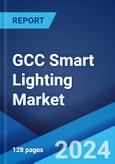Smart-lighting is a technology designed for efficient use of light resources with power-saving fittings and automated controls. Using smart lighting technology, the consumer is able to adjust the ambient lighting depending upon the occupancy or daylight availability. Smart-lighting products have extensive applications in commercial, industrial and residential sectors and consist of a smartphone-controlled wall keypad and a touchscreen panel. This adds significantly to the convenience of the consumer, as smart lights and bulbs can be programmed to switch on and off at any chosen moment. Various smart bulbs are engineered to produce light that resembles natural sunshine in order to make the consumer feel more productive and fresh, irrespective of night or day. Additionally, it provides a greater sense of security for those who are away from their homes and are able to turn on/off the house lights at their will. Smart lights are also available in multiple colors that add to the aesthetic value of the space and provides the user with a variety in décor and ambiance.
Consistently increasing energy consumption and electricity demands of the GCC region are among the key factors driving the smart lighting market in the region. Moreover, rising economic growth, population growth and increasing government support are also creating a positive impact on the smart lighting market in the region. Consumers are also increasingly adopting smart lighting products due to its cost efficiency and remote accessibility through smartphones and voice-command features. Additionally, increasing investments in smart homes and cities are expanding the market for smart lighting. Moreover, governments across the GCC countries have started to equip existing roads, tunnels and public areas with smart lighting equipment that work according to the occupancy and traffic on the road.
The publisher's latest report provides a deep insight into the GCC smart lighting market covering all its essential aspects. This ranges from macro overview of the market to micro details of the industry performance, recent trends, key market drivers and challenges, SWOT analysis, Porter’s five forces analysis, value chain analysis, etc. This report is a must-read for entrepreneurs, investors, researchers, consultants, business strategists, and all those who have any kind of stake or are planning to foray into the GCC smart lighting market in any manner.
Key Market Segmentation:
The publisher provides an analysis of the key trends in each sub-segment of the GCC smart lighting market report, along with forecasts at the regional and country level from 2023-2028. The report has categorized the market based on offering, communication technology, installation type, light source and application.Breakup by Offering:
- Hardware
- Lights and Luminaires
- Lighting Controls
- Software
- Services
- Design and Engineering
- Installation
- Post-Installation
Breakup by Communication Technology:
- Wired Technology
- Wireless Technology
Breakup by Installation Type:
- New Installation
- Retrofit Installation
Breakup by Light Source:
- LED Lamps
- Fluorescent Lamps
- Compact Fluorescent Lamps
- High Intensity Discharge Lamps
- Others
Breakup by Application:
- Commercial
- Residential
- Public Infrastructure
- Others
Breakup by Region:
- Saudi Arabia
- UAE
- Oman
- Kuwait
- Bahrain
- Qatar
Value Chain Analysis
- Key Drivers and Challenges
- Porters Five Forces Analysis
- PESTEL Analysis
- Government Regulations
Competitive Landscape
Competitive Structure
Key Player Profiles
Key Questions Answered in This Report
1. How big is the GCC smart lighting market?2. What is the expected growth rate of the GCC smart lighting market during 2023-2028?
3. What are the key factors driving the GCC smart lighting market?
4. What has been the impact of COVID-19 on the GCC smart lighting market?
5. What is the breakup of the GCC smart lighting market based on the offering?
6. What is the breakup of the GCC smart lighting market based on the communication technology?
7. What is the breakup of the GCC smart lighting market based on the installation type?
8. What is the breakup of the GCC smart lighting market based on the light source?
9. What is the breakup of the GCC smart lighting market based on the application?
10. What are the key regions in the GCC smart lighting market?
Table of Contents
Methodology

LOADING...
Table Information
| Report Attribute | Details |
|---|---|
| No. of Pages | 137 |
| Published | September 2023 |
| Forecast Period | 2022 - 2028 |
| Estimated Market Value ( USD | $ 397.5 Million |
| Forecasted Market Value ( USD | $ 1278.8 Million |
| Compound Annual Growth Rate | 21.5% |
| Regions Covered | Middle East |









